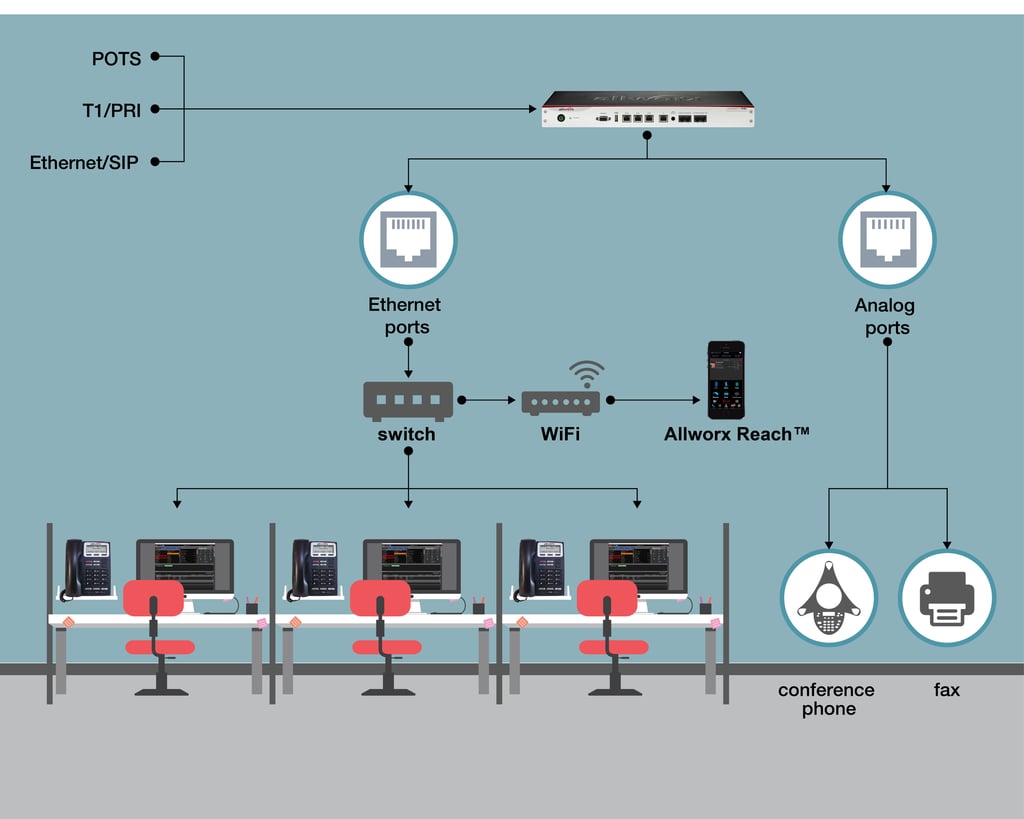VoIP, pronounced “voype,” stands for Voice over Internet Protocol. At its most basic, VoIP is simply a method for transmitting voice calls over a packet-based data network like the Internet. Imagine yourself talking on a phone with a friend. As you’re talking, your voice gets sampled 8,000 times per second, with each analog sample being converted to a number. The numeric samples are grouped into data packets, and these packets are then sent over an Internet network. Each data packet contains 20 milliseconds of voice data. When these packets arrive at their ultimate destination—in this case, your friend’s phone device—they are converted back to an analog signal and played out. Because all this happens before you can blink your eye, all you hear is a smooth continuous voice call.
Why VoIP?
Simply put, VoIP is a major advance in telecommunications. Think about the fact that since the first telephone was invented by Alexander Graham Bell in 1876, the dominant delivery method by which we make and receive calls hasn’t changed much until the last decade. The ability to receive a call without a physical wire directly connecting one device to another is a major game-changer in human communications. VoIP made a commercial debut in mid-1990 but didn’t catch on as a mainstream technology until mid-2000. The primary driver of the transition to VoIP is a desire to take advantage of the growth of data networks and their additional capabilities beyond the legacy phone network.
Analog vs. Digital vs. VoIP
Another way to look at VoIP within the larger context of telecommunication technology is how it differs from legacy analog and digital voice communication methods.
Analog phone service that you order from your local telephone company is called Plain Old Telephone Service or POTS for short (and pronounced just the way you’d expect). The most common service type is called Loop Start. Each analog telephone circuit requires a dedicated pair of wires and the voice signal is transmitted using a voltage running on those wires. When you see telephone poles with large diameter wires hanging between them, those carry hundreds of pairs of wires, each pair for a single circuit. The dedicated analog connections allow voice traffic to be sent with very low latency (delay) and with incredible reliability. The down side is that every potential phone call needs a dedicated pair of wires from the phone to a switching station, which leads to most of the pairs not being in use at any given time.
Digital phone circuits, a technical predecessor to VoIP, convert that analog voice traffic into a digital representation, much like VoIP does. The digital connection is less prone to interference that can result in a noisy call and allows for easier transmission of messages in addition to voice such as caller ID. Digital phone systems send out the samples over a dedicated circuit without gathering samples into packets. This results in low latency similar to an analog circuit, but digital connection has the advantage of enabling more calls to be sent over a single wire pair. For example, a T1 or PRI circuit from a service provider can carry 23 or 24 calls on a single pair of wires, thus dramatically reducing infrastructure costs.
So what’s big difference between digital and VoIP? The most important difference between a digital circuit and VoIP is that the digital circuit has a point-to-point connection with dedicated bandwidth for each possible call. This is great for guaranteed availability and low-latency voice calls, but doesn’t allow for any of that bandwidth to be shared for other applications when not in use for voice and limits voice calls to places that have a dedicated voice circuit.
VoIP technology uses the same data network for voice calls as for other data applications such as email, file sharing and Internet browsing. Sharing this common infrastructure provides great flexibility in where calls can be routed. In theory, a call can happen from any location that has access to the Internet. The down side to using a general purpose, shared network is that it isn’t as well optimized for voice applications as the legacy Public Switched Telephone Network (PSTN). So in theory, both reliability and voice quality can be compromised with VoIP technology, but in a well-designed solution, these don’t become real issues. In a network that is poorly designed or overloaded, bad voice quality is the first thing observable. An extra half second of latency when loading a web page is barely noticeable, but losing a half second of audio could change the meaning of a conversation.
Another unavoidable voice quality issue inherent in VoIP technology is increased delay in getting voice from one person to another during a conversation. This can manifest as the annoying echo you might have come across on some “Internet-based” call services. As the leader of hardware and system engineers at Allworx, a VoIP system manufacturer, I can personally attest that we spend a big chunk of our product development effort and time on delivering high-quality audio. With the right audio quality control in place, VoIP phone systems can produce superior audio quality to that of analog or digital systems.
What’s With These Confusing Acronyms?
If you started researching for a new business phone system on Google, you’d have come across terms like “IP PBX,” “VoIP phone systems,” and “IP telephone systems.” Well, I have admit our industry doesn’t do the best job at marketing and explaining our own products. Regardless of what these things are called, there are two basic concepts that are helpful to understand when you’re thinking about business phone systems:
- The type of voice service you’re getting from your service provider. Some common options you’ll hear are POTS, T1/PRI, or Ethernet/SIP.
- The switching device you’ll need to have at your office to distribute that voice service to the individual users or work stations within your office or building. Note that there are VoIP solutions where all of the phone system functionality is virtualized to the cloud. Commonly classified as hosted VoIP, this is a topic for another post.
That switching device has many names in our industry. In the analog world, the switching device was called a “key system,” “PBX or Private Branch Exchange”, “hybrid PBX system” or “hybrid key system.” For simplicity, I’m simply going to use the term PBX to describe this piece of premise equipment for the rest of this post. The purpose of the PBX is to route calls from the fixed number of lines from the telephone service provider to the usually larger number of phones at the business location. The PBX often includes a voicemail function and an auto attendant for helping incoming callers get to the right person (dial 1 for sales, dial 2 for service, dial 0 for the company directory, etc.). Depending on the required call routing functionality, these devices range from fairly simple in a small office to very complex in large call centers or sophisticated customer service environments (imagine what happens when you call the bank to get your credit card balance and never even talk to a live person to get your request taken care of).
VoIP phone systems, like the ones we make at Allworx, are a PBX with a VoIP interface on it. But that doesn’t mean VoIP PBX servers can’t support analog voice service like POTS. In fact, one of the key benefits of VoIP systems like Allworx is that it can work with any type of voice trunk (POTS, T1/PRI, SIP or any combination of them) while providing the advanced product features you can’t get from analog or digital phone systems. We even provide analog FXS ports for legacy devices on the premise such as analog conference phones and overhead paging systems.
Unique Features of VoIP Phone Systems

One of the key differences between digital and VoIP phone systems is the way in which the voice service gets distributed to the individual users or work stations.
A digital phone system requires direct cabling between the PBX and the individual work station. Let’s say you have to add eight more users but all the ports on your digital PBX are already in use. You’d have to purchase a port expansion card from the vendor and install cabling from those ports to the individual desk phones located in cubes or offices. If that sounds expensive and cumbersome, that’s because it is.
Unlike digital phone systems, VoIP phone systems use your office’s main Ethernet network. The VoIP desk phones can simply plug right into the same network that runs the users’ PCs. With VoIP phone systems, desk phones are essentially computing clients running on the office Local Area Network (LAN) much like PCs do. Adding new users to a VoIP phone system is so much simpler because you just have to program additional desk phones or extensions to run on an existing office Ethernet network.
Having your VoIP phone system running on a network rather than dedicated physical cables also means it’s equally easy to connect to devices located outside the office. For example, a VoIP phone system can program your extension to have incoming calls ring your desk phone in your office, on your mobile device, or on a remote phone in your home office – so you can stay connected wherever you are.
Lastly, because VoIP phone systems run on the main office Ethernet network, they can “talk to” other business applications to boost employee productivity. For example, you can program your VoIP phone system to talk to Microsoft Outlook so when you have a meeting coming up on the calendar, it automatically changes your phone presence to “In a Meeting” and updates the greeting and call route accordingly. VoIP phone systems can also integrate with third-party applications like Salesforce.com, which allows incoming calls to automatically pop open the customer profile so your agents or sales reps don’t have to.
What to Consider Before Buying a VoIP Phone System
Like any advanced technology, VoIP phone systems have a lot of advantages, but they are not without some drawbacks. First, you’ll find that VoIP phone systems are generally priced higher than most digital phone systems. If all you’re looking for is a dial tone to simply make and receive calls, a VoIP phone system is probably overkill.
Second, because VoIP phone systems are tied to office Ethernet networks, if your office network goes down, your phone system also goes down. It’s important to have a well-designed network for a VoIP phone system to work optimally and securely. No matter how good your VoIP phone system is, a bad network design can result in poor voice quality and introduction of security issues like phone hacking and toll fraud.
Third, if your outside phone connectivity is delivered over your Internet connection, your phone service goes down when the Internet service goes down. The most important key to overcoming this potential issue is to have a reliable, high-quality Internet service provider with a service level agreement that is in line with your needs for uptime. You need to know that any time there is a problem with the Internet connection, you’re going to have an expert team on your side working to resolve the issue right away. If your business requires voice availability 24/7, you should consider having a back-up plan. Some of Allworx’s customers are 911 emergency dispatch centers and they usually have set up POTS lines as a back-up in the event that their service provider’s network connectivity goes down.
Conclusion
So there you have it: a quick overview article on VoIP technology. I’ve only tried to hit the highlights here but with the amount of technical complexity behind VoIP technology, I could easily have written a dissertation and possibly bored you to death. But if you have specific technical topics you would like to hear from me, leave me a message and I’d be happy to address it future blogs.







